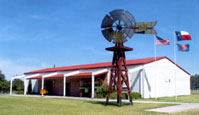|
August 21, 2011
WOLF CREEK HERITAGE MUSEUM NOTES by Virginia Scott MUSEUM HAPPENINGS Last week was a busy one and my desk looks like it. I have stacks everywhere, my email is blinking over limit, and notes from my peers are stuck everywhere on the other stacks. So I am hoping for a peaceful week. Our trip to Post last week was a fast one, we left on Monday morning, arrived Post in time for the evening events and attended the Tuesday all day conference, then drove home. I dropped Georgia off in Amarillo and journeyed on home. Worked on Wednesday to catch up with the core team and our mail. So this week I have to pay attention to the email, and other projects. On Wednesday, the collection of car Avon bottles of George Schoenhals was put on display. These bottles are quite interesting and accurate of vintage cars such as the 1936 Ford as well as the model 'A' Ford. They are displayed in our front case that we use for new exhibits. Remember, if you have a collection that you would like to share, call us. Come in and enjoy George's collection. We received two great books at the Plains Trail meeting. The first is entitled "America's 100th Meridian" which just happens the run down our Eastern border of our county. There are two maps in the book that will great for our display of our 100th meridian marker along with the text to give some history. The book will be added to our reference library. The second is entitled "Texas Quilts and Quilters" and gives the history of quilt patterns and quilters by three time periods: 1860-1920, 1920-1950, and 1950-2005. This will be a great reference to research our collection and have the history of the various quilt patterns. The meeting was very interesting and informative. A short trip but worth it. HISTORICAL MUSING This part of August lets us reflect on two different eras of Texas history. The first was the Civil War. On August 20, 1866, President Andrew Johnson, declared that "the insurrection in the State of Texas has been completely and everywhere suppressed and ended," officially ending the Civil War by issuing a proclamation of peace between the United States and Texas. Johnson had declared a state of peace between the U.S. and the other ten Confederate states on April 2, 1866. The last land battle of the Civil War took place at Palmito Ranch near Brownsville on May 13, 1865, more than a month after Robert E. Lee surrendered at Appomattox Courthouse. The second event was on August 17, 1899 when the criminal career of Thomas Edward (Black Jack) Ketchum ended. Tom and his brother Sam were members of a gang of outlaws that terrorized Arizona, New Mexico, and West Texas. Tom was born in San Saba Count, Sam in Caldwell county. They both left Texas in the 1890s and began a life of crime in New Mexico that included the killing a merchant in Carrizo and robbing post offices, stagecoaches, trains, and a railroad station. On September 3, 1897, the gang held up the Colorado southern passenger train near Folsom. On July 11, 1899, apparently without tom, the gang held up the same train again. Sam was wounded and captured. he died two weeks later in prison. Tom, unaware of Sam's failed attempt, tried singlehandedly to rob the same train on August 16. He was wounded by the conductor and was picked up from beside the tracks the next day. He was sentenced to death and was hung at Clayton, New Mexico, on April 26, 1901. The Ketchum gang was blamed for many crimes they may not have committed. Black Jack Ketchum may have inherited the nickname and reputation of Will "Black Jack" Christian. Will "Black Jack" Christian and his brother had a gang in Oklahoma and Arizona and was killed in 1897. |
 |
© 2006 - 2025 Wolf Creek Heritage Museum
All Rights Reserved |


